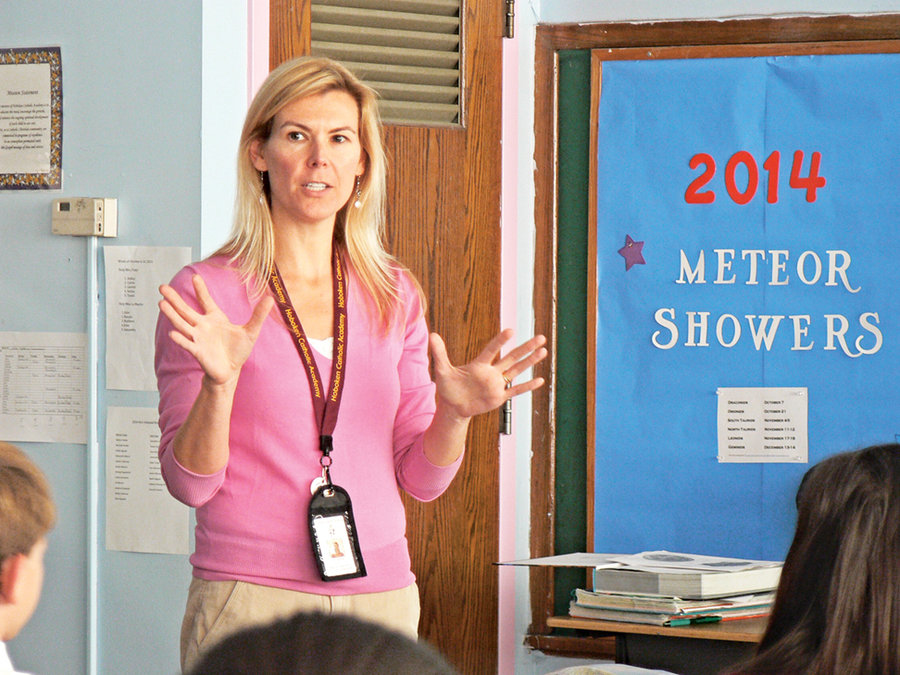The first time Erin Esteves worked at Hoboken Catholic Academy, she hardly ever made it out of the basement. After the Hurricane Sandy storm surge triggered an oil contamination in the crawl space beneath the academy building at Seventh and Madison streets, Esteves was called in as a senior scientist to help reclaim the site. Now she is back to reclaim a room of her own, not as a scientist, but as a science teacher for fifth through eighth graders.
Most buildings in Hoboken’s western edge dealt with flooding after Sandy, but few had problems like the academy. The storm surge penetrated a forgotten tank beneath the sidewalk, forcing an estimated 4,000 gallons of heating oil back through a tube to mix with eight feet of rain and seawater filling the boiler room of the school, according to academy Principal Matt McGrath.
Esteves first arrived on the scene in January 2013. Her firm EnviroTrac was under contract with the Archdiocese of Newark to address any environmental remediation necessary on its properties, and the academy was by far the worst hit school in the system.
After the deluge, me
As her team set about removing and cleaning the water, then the contaminated soil from the basement, Esteves was responsible for taking the pictures, soil samples, and water samples that gauged progress.
“We had the contractors under the building with these little tiny front-end loaders,” she said, “because of space we couldn’t get big machines—and they were hand-digging and removing the soil like ants would do.”
The entire building was air scrubbed to remove odors that, while not harmful, were unappealing. Finally, EnviroTrac covered the crawl space in a spray-on sealant to prevent future fumes from bubbling up. “If you were to go down there right now,” said Esteves, “it would just look like black plastic all over the whole place with a couple of monitoring wells sticking up out of the ground.”
“I had really had enough of climbing into dirty crawl spaces and being at gas stations.” – Erin Esteves
____________
The oil tank was cleaned, filled with sand or stone and abandoned in place. Removing it, said Esteves, could have undermined the foundation of the building and the street.
All told, says McGrath, Esteves’ team removed 50,000 gallons of contaminated water and 1,000 tons of soil. Elsewhere in the school, furnaces, plumbing, and the wooden floor of the gymnasium all had to be replaced.
That work didn’t come cheap. When the academy was awarded a nearly $1.2 million grant from the Federal Emergency Management Agency this past August, Rev. Alexander Santora, former pastors’ board chair of the Newark Archdiocese, told NJ.com that some of the new grant would be used to pay down debts for emergency oil decontamination.
While remediation took place, the academy relied on the kindness of fellow Christian schools in the area to keep going. Pre-kindergarten students relocated to space borrowed from the Mustard Seed School in the Our Lady of Grace gym at Fifth and Willow streets. Kindergarten through eighth grade children were bussed to the St. Nicholas School in Jersey City.
The Hoboken Catholic Academy reopened in September 2013.
Lessons from Sandy
The seeds of Esteves’ new job at Hudson Catholic were planted by end of her old one. She was laid off by EnviroTrac in July 2013, before the academy project was even complete.
She was actually “super happy” with the change. “It was eleven years in the business and I had really had enough of climbing into dirty crawl spaces and being at gas stations,” Esteves explained.
The layoff gave her the push she needed to pursue teaching, which had always been in the back of her mind. She entered New Jersey’s Alternate Route program, which allows non-traditional teachers to pursue certification while on the job.
Esteves credits her husband with finding the actual job listing at Hudson Catholic on the Newark Archdiocese website this past summer. “I was like, ‘you’ve got to be kidding me. Really? Really?’” she recalls. “There were a number of different openings for science teachers, so I just applied for all of them.”
Esteves had been out of work for a year and was eager to find a job teaching science. “I’m not really made to be a stay-at-home mom,” she said. “It was interesting for a year but I can’t really do that anymore.”
Initially, Esteves was worried that her past work might represent a conflict of interest. But when she sat down for her interview with McGrath, who had become the principal after her departure, “he thought it was great.”
After giving Esteves a tour of the school’s post-Sandy renovations, McGrath hired her on the spot. “I actually never saw the finished product until I came for my job interview,” she said.
Since starting class in September, Esteves has taught her students about the scientific method, classification, and cells, among other things. At the academy, she explained, science classes “offer a bit of everything” rather than focusing on just biology or chemistry for a whole semester.
She hopes to soon deploy her former scientific work as an object lesson for students.
“With the eighth graders, I was thinking I could have them calculate groundwater flow,” she said. Esteves is also considering inviting a geologist friend from her remediation days to come speak to her classes.
“I want to prepare them and have them mentally ready for not only high school and college but to be ready for what they’re going to have to do in corporate America,” she said.
Someday, perhaps, one of her students will complete the cycle by taking her old position. “Environmental consultants are always going to have jobs because there will always be tanks,” said Esteves.
Carlo Davis may be reached at cdavis@hudsonreporter.com.
